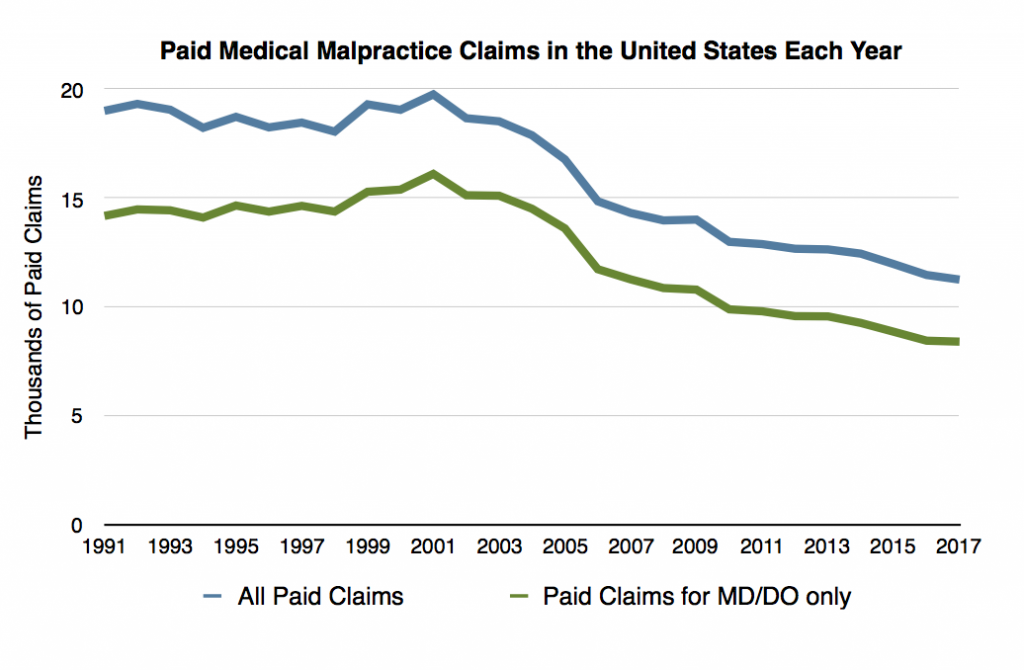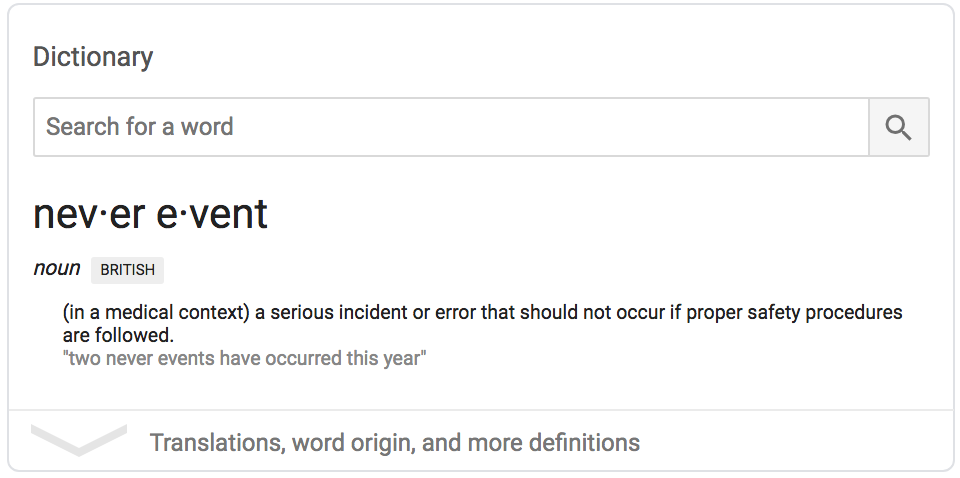Right now you have questions to ask and answers to weigh — do I have a malpractice case? How do I know if I have a medical malpractice case?
And if I have a malpractice case, well what then? Do I sue? And how?
In this guide we’re going to take a deep dive into how to start a medical malpractice lawsuit and how to determine whether or not you have a malpractice case to begin with.
We broke this medical malpractice guide down into 6 sections. Each section will either help you prep for your medical malpractice case, or answer the questions “do I have a malpractice case?” and “how do I sue for medical malpractice?” Here’s how it’s broken down:
Malpractice Case Background & Prep Sections (1-4)
► Sections 1-2: Prep by learning the common forms of malpractice cases and the myths surrounding malpractice lawsuits.
► Sections 3-4: Prep by getting a better understanding of malpractice in the ER — especially important if your case starts in the ER — and the reason medical errors happen, and often get swept under the rug.
“Do I Have A Malpractice Case? And How to Sue For Malpractice” Sections (5-6)
► Section 5: Answer the question, do I have a medical malpractice case?
► Section 6: Finally, learn the steps to sue the hospital and win your medical malpractice lawsuit.
Enjoy!
To start reading, just click the section below that interests you the most:
1. Know The 5 Common Types Of Medical Malpractice Cases
Let’s start with this — what do you think are the leading causes of death, in the United States?
Maybe heart disease comes to mind. Or cancer? We’ve all heard that word more than we should. Surely’s it’s high on the list.
How about accidents, diabetes, stroke? If you thought of any of these… you’re right. They’re all up there. In the top 12, in fact.
But medical malpractice? Many people wouldn’t think to mention that one.
According to a recent study conducted by Johns Hopkins, “More than 250,000 people in the United States die every year because of medical mistakes, making it the third leading cause of death after heart disease and cancer.” Yep.
Medical malpractice is the third leading cause of death in our country. How is that even possible in a country as developed as ours?
In this section, we’re going to cover the five most common types of the third most common cause of death, medical malpractice. Do you have a malpractice case that falls into one of these categories?
#1 Birth Injury Malpractice Cases

If you’ve searched through our site at all, you’ve probably noticed that we talk a lot about birth injury malpractice. It’s because we’re passionate about fighting for justice for families who’s child has been injured because of negligence.
Every family deserves to bring a healthy baby home. Of course, there are unforeseen circumstances and health conditions that are unavoidable, but if something negligent did happen, someone needs to be held accountable.
Birth injuries can occur in many different ways, such as nerve injuries, cerebral palsy, medication mix ups, and misdiagnosis. These injuries are costly, not just financially, but physically and emotionally as well.
Sometimes the injury is obvious, and other times they may not notice for quite some time. Either way, it’s important you reach out to a medical malpractice lawyer as soon as possible, as you have a limited window of time to seek legal action.
#2 Prescription Drug Malpractice Cases

Each day millions of patients are treated in healthcare facilities across the country. It’s no easy feat, considering the numbers of patients compared to medical staff, and there’s always a need for more healthcare professionals. Some people pursue this field because of passion and the desire to help others. For others, maybe it’s for more practical reasons, like job security and good salary. Whatever the reason, the common thread among all medical professionals is that they’re human.
Humans make mistakes. Workers are often overworked and fatigued, which of course spikes the chance of a mistake occurring. Other times, people simply don’t pay enough attention. Whatever the reason, there has to be consequences for sloppy care. Errors like medication mix ups, prescribing errors, and overdoses shouldn’t happen.
It’s important that there’s clear communication among healthcare professionals, that charting is accurate and up to date, and that medications are labeled correctly.
All precautions need to be taken in order to avoid mistakes like these. But when people fail to take the proper precautions, mistakes happen, people get hurt, and they come to medical malpractice lawyers like us to seek justice and compensation.
#3 Surgery Errors That Lead To Malpractice Cases

We’ve all heard stories of surgery gone wrong. Like a doctor sewing up a patient with a medical instrument left inside. It sounds crazy, but it happens, and more often than you might think.
Surgical errors aren’t limited to foreign objects left behind, but also:
- Operating on the incorrect body part.
- Anesthesia errors.
- Damaging healthy organs while performing surgery.
- Failure to properly monitor vitals and blood supply.
- Not taking enough precautions to avoid infection.
Like prescription errors, surgical errors often occur because of negligence at the hands of healthcare professionals. Surgery is meant to correct an existing condition, not create new ones. If you think you may have a medical malpractice case, read the chapter below titled Do I Have A Medical Malpractice Case? to find out, or give us a call.
#4 Misdiagnosis Malpractice Cases

Misdiagnosis happens a lot more than it should. In fact, diagnostic errors occur in 10%-30% of all medical cases. When a condition like heart disease or cancer is misdiagnosed, the results are often fatal. If you find an illness early on, the chances of survival are significantly higher. But what if you were diligent and expressed concerning symptoms to your doctor but they didn’t listen? Or maybe they didn’t take you seriously, and blew you off? Testing could have been done. Your medical record and family history should have been carefully scrutinized.
All too often patients don’t receive the treatment they should. If your doctor wasn’t comfortable with treating you, they should have referred you to someone who could. The worst scenario is knowing you could have survived had the disease been found earlier.
If this has happened to you or your loved one, reach out to an attorney. Poor care or untimely death because of misdiagnosis isn’t fair. There are things you or your family member can do to make it better.
#5 Failure to Treat Malpractice Cases

So a diagnosis has been made… but the treatment wasn’t timely. Or you went in for surgery, but were released too soon and later got an infection. Healthcare professionals are responsible for seeing the big picture. Knowing which steps should be taken and how to get you back to health is a big part of their job.
There’s a reason you’re seeking care from a health care professional… because they went to school for years and trained to recognize signs and symptoms. They have the knowledge but if they’re not passing that on to you, what’s the point?
When a doctor or medical professional fails to treat you because of negligence or substandard care, it may be malpractice.
No one wants to think about medical malpractice. That’s probably why most people don’t realize that medical malpractice is one of the leading causes of death in the United States. But changes won’t happen if people don’t know the truth about malpractice, and what they can do if they become a victim of malpractice.
If you or your family member has dealt with any form of medical malpractice, please reach out to us or an attorney in your area. The first step can seem hard, but it’s probably much easier than you think, and it’s the only path to justice and compensation. But you’ll want to avoid falling prey to the malpractice myths below.
2. Understand The 5 Myths About Malpractice Cases
Whether you’re in Alaska or here in Houston, contacting a medical malpractice attorney near you can seem like a daunting task.
That’s the first myth we’ll unravel, by the way.
The rest of our malpractice myths include:
► Medical malpractice claims are typically frivolous.
► There’s many more medical malpractice claims than actual malpractice.
► Medical malpractice claims increase health care costs.
► All medical malpractice attorneys are the same.
Let’s dive right in!
#1 Getting A Medical Malpractice Lawyer For Your Case is Difficult
Far from it. We can’t speak on behalf of the other malpractice attorneys out there, but for us, all you have to do is dial our number and we’re there, 24/7.
Or send us a message. From there, we do the heavy lifting for you.
We guide you through the process with over 60 years of collective experience.
And if you live far away from Houston Texas, here’s some simple options to find a good malpractice lawyer (and here’s a list of criteria to help you pick the best of the best):
1. Talk to your family, friends & acquaintances for recommendations.
2. If you know a lawyer you trust, ask if they have any recommendations. (Hint: They will.)
3. Create a list of medical malpractice attorneys near you and interview them, asking questions that will reveal their quality and ability.
Again, we can’t speak for other attorneys, but the vast majority of law firms make you, the prospective client, the #1 priority. That means that, aside from the mental hurdle of picking up the phone, that first conversation should actually be pretty easy.
#2 Your Medical Malpractice Lawsuit Is “Flippant.’

This is another myth that couldn’t be farther from the truth. In fact, this study from Harvard School of Public Health shows that only 3% of medical malpractice claims could be considered flippant, or “frivolous.”
The problem is that most of the lawsuits that garner our attention are the ones that are sensationalized and wrung out by the media. Like the man who sued a dry cleaner for $67 million when they lost his pants, or the woman who spilled coffee on herself then sued for $2.7 million. These cases are frivolous, but they’re also few and far between.
We’re not hearing about the mother who’s baby was carelessly treated during birth, or the individual who is now quadriplegic because of a surgery error. Every-day people whose lives have been forever altered because of a medical mistake. People who deserve justice. There’s nothing flippant about that.
#3 There’s Many More Medical Malpractice Claims Than Actual Malpractice.
Malpractice, sadly, occurs much more often than medical malpractice lawsuits. The reasons vary. Sometimes doctors hide or make light of their mistakes. Sometimes patients trust their doctors more than they should and never realize they’ve been diagnosed incorrectly, or given the wrong dosage, or have been operated on for the wrong surgery. Et cetera, et cetera.
The moral buried in this myth is to keep your eyes open and be aware — malpractice happens, and it happens often. And when it happens, the chances of the doctor breezing over the mistake or outright hiding it are much higher than you’d think.
You can read more about the rise in medical errors and doctors hiding them here.
#4 Your Medical Malpractice Claim Increases Health Care Costs.
Nope. Not so much. A number of insurance companies, and even members of government spread this myth.
In fact, medical malpractice claims decreased by over 50% since the early 90s, while…


…healthcare costs dramatically increased.


The premiums doctors pay for medical malpractice insurance are probably a lot less than you think. And as mentioned before, the number of cases filed has significantly dropped in the last twenty years. This just isn’t the issue many believe it is.
Want to know what is responsible for US health care being twice as expensive as other developed nations?
According to researchers at Harvard Chan School, the problem is inflated prices.
► Doctors and nurses get paid twice as much, for one (and the care is similar and often lower in quality compared to other developed nations).
► Drugs are incredibly expensive.
► Hospitals in America pay more for diagnostic tests and administration too.
And there you have it. America’s health care is ridiculously expensive, but medical malpractice claims have little to do with it.
Next up, the myth of equality.
#5 All Medical Malpractice Attorneys Are The Same.
Imagine a salesperson, chatting with one of her fellow salespeople, says “you know, I really think every salesperson in this company is equally good.”
It’s just an unfair assessment. We all know that no two people are alike, whether we’re talking salespeople or attorneys. Some people are just better at certain things than others. You wouldn’t hire a family lawyer over a medical malpractice lawyer, if you’re trying to prove medical negligence, right?
More importantly, you wouldn’t hire a bad lawyer over a good one.
That is, if you knew better.
You need to do your research. Don’t place your trust in just anyone. Be selective and hire an attorney with a proven track record, and ideally an attorney whose focus is solely one area of law.
Hopefully we were able to help debunk a few of the common medical malpractice myths you may have believed. Now that we’ve covered the myths, it’s time to take a deep dive into malpractice in the ER.
3. The Medical Malpractice Cases That Start In The ER
When stakes are high, doctors NEED to make quick and calculated decisions in order to save lives. But what happens if your doctor makes a bad call in the ER? Do you have a malpractice case, or not so much?
In this article we’ll help identify what emergency room medical malpractice looks like, and what you can do if you or your loved one has been a victim of it.

Common ER Mistakes
Each day, nurses and doctors clock in for their shift. Shifts that are long, tiresome, and unpredictable. Without a crystal ball, there’s no way to foresee what any given day may look like. Will a patient with a traumatic injury arrive via ambulance, or will a worried father of three check in for chest pain?
Working in the ER is tough, there’s no question about it. But when the average emergency room doctor makes $252,235 per year, and has sworn to the Hippocratic Oath, don’t they owe you their best? Burnout and fatigue aren’t good excuses when a patient dies.
Let’s take a look at some of the mistakes a person may experience:
Failure to…
► Failure to do a full physical exam – The four primary vital signs are blood pressure, pulse, temperature, and respiration. Continually monitoring these vital signs is crucial for a patient to have the best chance of survival. If your nurse or doctor isn’t doing this very basic thing then they’re failing you.
► Failure to test for life-threatening conditions – What’s the use of technology if your doctor isn’t using it? With high tech imaging and detailed lab tests available, doctors have to make use of these amazing resources in order to do their job well. Invaluable resources that help diagnose and treat.
► Failure to promptly correspond with specialists – There’s no way a doctor can know EVERYTHING. With countless diseases and different approaches to treatment, there’s a reason doctors often choose an area of medicine to specialize in. If your doctor doesn’t have the knowledge necessary to treat you, they should be referring you to a specialist that does.
Making an Error in…
► Prescribing the wrong medication or incorrect dosage – Medication errors can be deadly. Accidental overdoses usually occur when protocol isn’t followed or staff members don’t pay close enough attention. Even Hollywood star, Dennis Quaid, dealt with the devastation of a medication error when his newborn twins were accidentally overdosed. Thankfully they survived.
► Surgery – Everyone makes mistakes…we get it, but the operating room isn’t the place for foolish surgical errors and negligence. Leaving a 5 inch scalpel in a patient’s abdomen is insane. Sometimes doctors even operate on the wrong body part. Yikes.
► Patient dumping – This may shock you, but sometimes hospitals “dump” patients that don’t have the means to pay for services. “Victims typically fall into one or more of the following categories: those with a mental health condition, undocumented or under-documented immigrants, and the homeless,” reads one article on patient dumping. A patient in Maryland was left at a bus stop in the freezing rain, with only a hospital gown on.
Example: A Young Mother’s Story
Let’s paint a picture of what negligence looks like. Theresa Boland, a young pregnant mother fought tooth and nail to receive treatment. At just 30 years old, she certainly didn’t suspect a blood clot, but she knew something was wrong.
And that’s why she made her way to the ER. Her leg pain was severe and was accompanied with redness and tingling. But doctors brushed off her symptoms (at three separate ER visits) as assuperficial thrombophlebitis, sciatica, and cellulitis. Not one incorrect diagnosis, but three! After multiple ER visits, three ultrasounds, several phone consults, and a visit to her PCP she received the correct diagnosis: acute deep vein thrombosis (DVT) or a blood clot.
“My DVT experience was terrifying and frustrating. I cannot understand why it took a series of doctors and repeated ultrasounds to diagnose my DVT, especially since my symptoms were classic.”
-Theresa Boland
What would have happened if Theresa’s diagnosis had been delayed any further? Would Theresa and her unborn daughter have made it? Read Theresa Boland’s full account of her story.

ER Malpractice Can Cause Serious Injuries
Nurses and doctors play a significant role in the well-being of their patients. Generally they do a terrific job, but occasionally they make a mistake…and in emergency situations, those mistakes can be quite serious.
When medical malpractice occurs, it can result in paralysis, an diagnosed stroke, severe cardiac damage, a life threatening infection, and can produce many other issue. In the worse case scenarios, some patients even die.
What You Should Do If You Think You Have A Malpractice Case
Medical malpractice errors can be costly, and not just in a financial sense. The emotional turmoil, alone, is so so heavy.
Bills pile up and wages are lost. How do you handle disability care, rehab, or burial costs?
It’s a lot to handle but you don’t have to solve your case alone. A lawyer can fight on your behalf, and potentially help take back those financial losses and more. It certainly won’t fix everything, but it can help.
You don’t deserve to be in this situation. If your or your family member has been harmed by medical malpractice, and you believe you have a case, please contact our office so we can help you.
Still not sure if you have a malpractice case? Read on, the answer’s below!
4. What Causes Medical Malpractice Errors & Why Are They Hidden?
What’s the main cause of medical errors?
And how often do doctors make those mistakes?
Do doctors actually hide their mistakes?
These are not easy nuts to crack.
Let’s touch on medical errors —
Some say most medical errors are caused by communication problems. Others say workflow issues, or incorrect patient records or technical failures.
But these are leaf and branch issues — we need to dig to the root of the problem.
In this article, we’ll look into:
► How burnout may increase medical errors by 200%
► The main reasons for doctor burnout
► How often doctors make mistakes
► Whether or not doctors hide or gloss over medical mistakes
This subtle killer has officially claimed the bronze medal for taking the most lives in the US.
Ranking behind only heart disease and cancer itself, medical malpractice is the third leading cause of deaths in the US.
Why?
That’s the million dollar question. One of the most likely culprits is (perhaps not too surprisingly) burnout.
Sadly, Doctors Are Burning Out More Than Ever
Let’s cover 3 things really quick. First, money. Money holds a lot of sway over the mind, and doctors are far from immune. Most doctors are plagued with medical school debt up to their ears, typically around $200,000 worth, but some pushing North of half a million.
This debt takes most doctors 10 to 30 years to pay off. That’s stressful.
Next up, hours worked. The average doctor works roughly 60 hours, or 1 1/2 times more than the average American. Also stressful.
Last up is suicide. Or more accurately, the work environment that leads to it. The sad truth is, doctors are twice as likely to commit suicide than everyone else in the US. On average, 1 doctor commits suicide every day in the US.
The sum of these problems, in a word — burnout.
According to a recent study on burnout and malpractice, doctors who report signs of burning out are twice as likely to make medical errors.
And that’s just the start.
Here’s A Few Stats To Get You Thinking:
► An increasing number of doctors say they’re clinically depressed, or show clear symptoms of depression.
► 9 out of 10 doctors discourage others from joining the profession.
► Worst of all, nearly half of doctors report that they’re burned out (42%).*
That places patients in a tipsy boat threatening to capsize into an ocean of physical, emotional and financial turmoil.
That is, the risk of becoming a victim of medical negligence is high. And unless patients are aware and able to do something about it, they’ll suffer quietly with no justice, physically, emotionally, and financially.
Medical Errors: How Often Do Doctors Make Mistakes?
How many mistakes do doctors make each year? How often do doctors make mistakes?
While this is impossible to know completely, the numbers we do have point to a severe problem:
► More than 1 out of 10 patients are harmed over the course of their medical care. *
► Medical errors result in 250,000 deaths each year. *
► More than 7 out of 10 doctors say they’d admit little or nothing if they made a medical error, and most say they wouldn’t even apologize. *
That means we’ll never know precisely how often doctors make mistakes, because many if not most of them will hide it if they can.
Or best case, “admit little.”
Your Hospital May Hide Medical Errors (& Thus Your Malpractice Case)
Now, our medical system is flawed, but hey, what system isn’t? The main takeaway here isn’t that humans create flawed systems. We all get that, much more than we’d like to. No, the point is that you, the patient (or parent or child or other relative of the patient), need to be aware of this.
Many doctors hide mistakes. And too many patients trust them blindly.
For all of the people who stand up for themselves when they feel mistreated, there’s countless others who don’t. And a big reason why they don’t is because medical professionals are seen, by many if not most, as the authority on the subject.
Many people never even realize they’ve become victims of malpractice because they trust authority to a fault.
They believe in a broken system brimming with stressed, over-worked, depressed and likely medicated individuals who make mistakes and oftentimes, refuse to admit it.
And the consequence? These patients suffer with no justice or recompense. Or worse still, their powerless, innocent child does.
Don’t let that be you.
Be Aware Of Medical Errors To Protect Yourself, Your Family & Your Case
So. Our medical system is flawed. Our doctors are human. When you take into consideration the mountains of debt on their shoulders, the sheer volume of hours they work, and the piddly wages (compared to the debt) they earn, it’s easy to feel for them.
As Americans, we can easily sympathize with work hours that would make many countries dry heave at the thought, wages lower than we think we deserve and larger than life personal debts.
But we can, perhaps even more so, empathize with the need for justice. We all make mistakes and we all must take responsibility for those mistakes. And the bigger the error, the bigger we pay.
Doctors, like the rest of us, should be held accountable. If they make a medical error, they should receive a fair punishment that fits the crime. And on the other side of that coin, the patient should be fairly compensated.
If you’ve been mistreated by the medical system — even if it is by a doctor or medical professional who probably otherwise means well — You. Are. Owed. Plain and simple.
Take action and receive proper compensation.
It may not be a fair trade, but it’s something. Justice, or near it.
Now, let’s take a deep dive into the million dollar question (possibly literally): Do I have a malpractice case?
5. Do I Have A Medical Malpractice Case?
Do you think you have a medical malpractice case against your doctor?
Fact is, you might. And you might not. Common sense doesn’t always dictate in the court of law, and what may seem like a clear cut lawsuit may not be. But one way or the other, this is a great place to start. Because you’ll be able to either confirm that you have a case, or that you don’t.
Let’s start with the home runs. That is, if you answer yes to one of the questions below, it’s looking good. Really good.
YES = You Likely Have A Medical Malpractice Case

Did they leave a surgical sponge or other foreign object inside of you after performing surgery?
This happens waaaay more than it should. 4,000-6,000 times more than it should. Yep. You read that right — in the US, 4,000 cases are reported each year, of surgical items being left inside a patient. And experts believe the actual number is closer to 6,000! That means that roughly 12 US surgeons per day who sew up their patients only to remember they’d left a foreign object inside of them. Oops. BIG oops.*
FYI, here’s a few of the most common objects left inside a patient:
► Scalpels: Blades for making surgical incisions.
► Retractors: Tool that holds incisions open.
► Sponges: Material not unlike gauze, to soak up blood and keep it from pooling.
► Clips/clamps: Tools used to pinch off blood vessels.
► Needles: Used to sew stitches and sutures.
So they left something inside you? Good. You almost definitely have a malpractice case.
Next up, the unwanted operation.
Did they perform an operation on you that you did not need?
Home run number two. If they operate on your arm to remove a tumor, but it turns out your x-rays had been switched with another patient’s and you don’t have a tumor after all, guess what? That’s medical malpractice. Time to talk to a malpractice attorney and plan your lawsuit because it looks like you have a case.
Did they perform an operation on you that was meant to be for a different patient?
Patient A needs their tonsils removed. You (patient B) need lower back surgery. They remove your tonsils. Not cool, but congrats — that’s malpractice. You sir or ma’am, have a medical malpractice case. Same goes for the wrong part of the body, which brings us to question 4:
Did they operate on the wrong part of your body?
Let’s say you go in for an appendectomy. They put you under for the procedure. You wake up expecting to feel a little sore in, you know, your appendix region. But instead, you wake up to a missing leg. Yikes. That’s a home run and then some — time to call the best malpractice lawyer you can find, because you just might have a case.
Did they perform surgery without your consent? (Non-emergency only.)
You wake up confused and sore. Questions are asked. “Wait, why on earth didn’t you ask me first?!” you project, eyes justifiably bulging. They fumble around with some silly answers including how they’re legally clear to perform emergency operations without consent. But a vasectomy? That hardly seems like a justifiable emergency to you.
And you’d be right to second guess, because you have a granite-solid malpractice case. Grab the nearest attorney and sue away. (Actually just kidding — find the best attorney and medical staff.)
Did they fail to inform you about a significant risk? (A risk that has more than a 5% chance of occurring.)
Here’s the situation. Your doctor solemnly tells you that you have a narrowed carotid artery that needs to be opened so you don’t have a stroke. “Great!” you smile, and the next thing you know, your surgeon inserts a stent into your femoral artery, threads it through until he reaches your carotid, then inflates a balloon through the stent, successfully expanding your carotid artery. Yay! Wait no, not yay — they didn’t tell you the mortality rate, did they? Nope. 32% – that’s the mortality rate at two years after this sort of operation. That’s a big no-no and it’s on you to lower the hammer of justice.
Now, if you answered yes to any one of these questions, you almost definitely have a medical malpractice case. Congrats! What’s next? Give us a call, and we’ll walk you through the process to get you paid! It can be annoyingly complex, but that’s why we’re here — so it doesn’t have to be for you.
If you didn’t have any yes–wins to the questions above, fear not. Many if not most cases aren’t 100% obvious wins from the get go. Our team of medical malpractice attorneys and medical staff is here to help you straighten everything out to determine whether or not you have a case.
So how do you know if you have a medical malpractice case if you didn’t have a yes for any the questions above?
Read on, to our “not-quite-home-runs-but-still-possibly-a-case-q-and-a.”
YES = You Might Have A Medical Malpractice Lawsuit

Were you injured during a medical procedure or because of a treatment?
Now, this may seem like an obvious win. You’re suffering in some way because your doctor messed up! But not all mess ups are considered malpractice.
That said, if you believe you’re suffering because your doctor messed something up, and you’re a smart, reasonable person, there’s a pretty good chance you’re right.
And this is the best part. All it takes is a quick call to find out.
Do you believe your doctor’s or nurse’s treatment was below medical standards?
The big question here is why? If you have a good reason, the best thing you can do is immediately contact the best attorney you know. The average medical malpractice settlement is over $425,000 and the average jury award is over $1 million. 9 out of 10 cases settle.* You don’t want to give up a chance to win $.5 million to $1 million, do you?
Does your doctor have a sketchy past littered with malpractice?
This is far from a home run, but still a pretty solid indicator that you’re on the right path. But how do you find out? Dig up their medical history online! You can use this online physician search tool from the Federation of State Medical Boards to look your doctor up.
Even if you don’t suspect a doctor of malpractice, and just want to know who is treating you or your family (or maybe you have a new doctor) it’s always nice to know that you’re in good hands. And if you’re not, you can find a better doctor!
Last but not least — there’s one automatic disqualifier you should know about. Sadly, your window of opportunity isn’t open forever. With that in mind, the next section will help you determine whether yours is or isn’t.
Are you within your state’s statute of limitations?
This is a biggy. If the answer to this question is no, I’m sorry to say, you don’t have a medical malpractice case.
How do you find out?
Well, let’s start with this. As of the date this article was written (and aside from suing government agencies), every state gives you at least a year. For example, here in Houston and the rest of Texas, you have up to 2 years after the day of the personal injury incident.
If you don’t live in Texas, use this personal injury statute of limitations chart to find out how long your state gives you.
Keep in mind, there are some very rare exceptions to these rules, possibly in your favor but also otherwise. A quick chat with your medical malpractice lawyer should set things straight.
Final Thoughts On Your Medical Malpractice Case
So that’s that. Hopefully you just found out some good news! If you’re in Houston Texas (anywhere really), and you think you have a lawsuit, we can help you confirm today.
Give us a quick call at (713) 658-0231! Why? Because you matter. And also, math. Remember, how 90% of all medical malpractice lawsuits end in a settlement?*
That means, if you call us and we team up to pursue the lawsuit together, there’s a very high chance that you’ll be compensated through settlement. The average settlement, again, is $425,000. Not bad.
So find out! You may have a case, and you may not. But risking 5 minutes to possibly come out around $.5 million ahead? Way better than playing the lottery.
But what happens after you find out you have a case? Well. You prep, and then do your best to sue for malpractice and win compensation. Here’s how.
6. How To Sue For Medical Malpractice & Where To Start
If you need to know exactly how to start your medical malpractice lawsuit, and how to sue for medical malpractice, you’re in the right place.
Because we’re going to cover the process as well as:
1. How to report medical malpractice.
2. The difference between adverse events and malpractice.
3. Criteria to choose a winning lawyer for your lawsuit.
4. 4 of the most common never events that lead to winning a malpractice case.
5. And more.
Let’s jump right in!
Prep & Sue For Medical Malpractice — The Process

Suing for medical malpractice requires 5 stages:
1. The investigation.
2. Filing suit.
3. Pretrial discovery.
4. Negotiations and settlement.
5. Trial prep and the trial itself.
Before any of this, you’ll need a lawyer. You’ll want to report malpractice too, but we’ll focus on the lawsuit process first.
Step 1: Start With The Investigation
This step is pretty simple for you, because we (or your lawyers) are going to do all the work. In this stage, we’re going to find the answer to two simple questions:
1. Negligence: Was the doctor or medical professional negligent in the eyes of the law?
2. Injury: What was the injury you received because of their negligent care?
If it truly is a matter of medical malpractice, we can move forward to pursue the medical malpractice case. How?
By getting the medical records reviewed by an expert in that field.
Here’s how to get a valuable testimony from a physician who knows the area of medicine involved in your case:
Make sure your attorney has contacts in the medical community. This will help identify qualified expert witnesses.
Understand that a determination can only be made by a doctor who practices in that area of medicine. In most cases anyway.
Many states (including Texas) require an expert’s medical opinion. It’s mandatory to prosecute a medical malpractice lawsuit.
Pro tip: A lot of people ask “how long do I have to file a medical malpractice case?” This varies, but we can tell you this — in Texas, it’s almost always 2 years from the date of your injury. Read more about malpractice time limits.
Step 2: File Your Malpractice Suit Against The Hospital
Once we (or your lawyer) receive the opinion of our medical expert, we can prep and file a lawsuit on your behalf. We file suit and serve copies of the papers on the defendants.
Their lawyers file Responsive Pleadings, which is called Grounds of Defense, in response. Now we’re getting somewhere.
Step 3: Pretrial Discovery
This is divided into three parts:
1. Written Discovery: Each party sends written questions, or Interrogatories to their adversary. They send a request for relevant documents as well. Both sides must provide written answers and hand over all copies of documents relevant to the case.
2. Depositions of the Parties and Lay Witnesses: These are testimonies under oath, conducted outside of the courtroom. We use these depositions to assess the adversary. Like all responsible attorneys, we prep you thoroughly for this process.
3. Depositions of Expert Witnesses: Once our experts complete their opinions on the case, we tell the defense who our experts are and the details on their opinions. The defense will depose our experts, and we’ll depose theirs. In the same way you were thoroughly prepped for your deposition, the experts will be too.
Step 4: Negotiations & Malpractice Case Settlement
Now, here’s some good news. The vast majority of medical malpractice cases never go to trial. Why?
Basically, hospitals usually know they’ll lose in court, and choose to negotiate and settle instead. That means you’ll be well compensated for your injury. However, not every case settles. If your case doesn’t settle, it’s on to step 5…
Step 5: Your Malpractice Trial Prep & Trial
If the defense refuses to give us a fair offer, our experts will testify in court. But before that, we prepare. A lot. Hours of preparation are necessary. This is to make sure our visual aids, exhibits, opening statements, closing arguments, and everything in between will set us up for success.
We hold pre-trial conferences with you, as well as our witnesses and experts, so everyone’s on the same page and knows exactly what to expect. Focus groups with people similar to the potential jurors help us understand how the jury may respond to the case. This is just a simple overview — there’s much more that goes into the process, but that’s the bird’s eye view.
By the time we get to the trial, we’re well-prepped and ready. Of course, it’s impossible to predict the outcome of the trial. But we do everything in our power to help you win your medical malpractice case ethically and within the scope of the law.
And there you have it. That’s your medical malpractice lawsuit process in a nutshell. Now that we’ve covered how to sue the hospital, let’s take a step back to cover how to report medical malpractice as soon as it happens.
3 Steps to Report Medical Malpractice

First, why would you want to report medical malpractice? Well, there’s a couple good reasons. First, there’s a chance that the doctor or hospital will have to stop practicing.
Second, it may force them to quickly offer you money to settle. More details on that in a moment.
Step 1: Report the Hospital or Doctor
Report medical errors as soon as possible to your state’s medical complaint board. Don’t expect a response. Also, unless multiple complaints have been issued against this hospital or doctor, they’re unlikely to do anything about it beyond filing the report and notifying the doctor and hospital of the complaint.
Step 2: Gather the Information Needed to File a Report
When filing a report, it’s not necessary for a patient to submit a medical opinion. Patients reporting medical errors aren’t doctors, and that’s okay. Instead, you should include as many details as possible about the incident. Especially firsthand information.
Step 3: See if the State Board Agrees
First, this does not initiate a medical malpractice lawsuit — Filing a report with the state board is intended to only affect the ability of the doctor or hospital to continue practicing, rather than to compensate the patient for injuries sustained.
That said, this may trigger the insurance company of the responsible parties to try to offer you money to settle.
Pro tip: If they offer you a settlement, don’t accept it before you consult with your attorney. A good medical malpractice attorney will be able to estimate the value of your damages and determine whether or not the offer is acceptable.
The Difference Between Medical Malpractice & Adverse Events

Malpractice is a fairly complex subject, with a wide variety of things to consider.
Let’s start with the difference between adverse events and medical malpractice. These have distinct differences that determine whether you have a lawsuit or not. This is how to differentiate between adverse events and malpractice.
Adverse Events Definition
Adverse events are unavoidable risks that come with specific medical procedures or treatments. They’re events that the doctor can foresee and prepare for. Here’s an example of an adverse event.
So, a patient undergoes surgery and the doctor prescribes her a new antibiotic.
She sustains an injury because of an allergic reaction. Unfortunately, she couldn’t produce medical records of the allergy that existed prior to the prescription. In this case, the doctors would not be at fault because they had no way of knowing. Adverse event.
Malpractice Definition
Medical malpractice happens when a doctor or physician fails to diligently follow standard protocol that exists to protect patients. It also includes a doctor’s failure to do something, which is negligence. Let’s take the previous example.
Say the patient was prescribed antibiotics after their surgery and still developed an allergic reaction. This would be malpractice if the allergy was stated in the patient’s medical records and the doctor failed to check before the prescription. The doctor would be at fault and the patient could file a claim of negligence against them.
Why Does it Matter?
When considering medical malpractice, you need to know the difference between adverse events and malpractice. Some procedures and prescriptions come with inherent risks.
The patients are told and have the ability to decide whether they accept the risks. In this case, this will not qualify as malpractice. If the doctor makes an error that could have been avoided, that is a claim.
How To Find The Right Lawyer & Sue For Medical Malpractice

Let’s start with the obvious. If a loved one is killed because of medical negligence, the next step is pretty straightforward. Prove the case. Recover compensation.
But malpractice cases are complex. Experience isn’t a luxury, it’s absolutely vital to your success.
In the case of a wrongful death due to a medical mistake, a family is often
reeling from the bad news. Often, they’ll wonder if they have a case or not. A good lawyer will help you figure that out, and help you get compensation, step by step.
The Criteria A Winning Malpractice Lawyer & Firm Should Meet
Attorneys are people and firms are made of people. As such, none are perfect. But with that in mind, this is how to win your medical malpractice case:
You get as close to perfection as possible.
Here’s a list of criteria to help you choose the best lawyers for your malpractice lawsuit.
They have worked extensively in malpractice and can tell you if the death was purely accidental or caused by a doctor mistake.
Experienced attorneys can also put family members at ease. Because they’ve successfully held many doctors and hospitals accountable in the past.
Years of trying cases in civil court, which means your lawyers know and understand the nuances of judges and juries.
Your attorneys should meticulously prepare your case, well before the first day of a trial.
The firm you choose should ideally have a registered nurse on staff.
Well-seasoned malpractice lawyers can confidently go up against powerful defendants in a wrongful death lawsuit. These can include physicians, hospitals, nursing homes and other entities who often have considerable clout.
Last but not least. Following the loss of a loved one, family members often don’t know where to turn. By sharing what they know with experienced counsel, they
can gain a sense of purposeful direction in light of unexpected tragedy.
4 “Never Events” That Result In Winning Medical Malpractice Claims

According to John Hopkins Medical Malpractice Study, an average of 4,000 never events occur each year. These events are simply unacceptable.
People injured in these cases should always seek compensation.
The most frequent never events happen during surgery. When the surgeon or their staff is negligent, they can cause irreparable harm.
Here’s 4 common never events:
1. Surgery on the Wrong Body Part
For patients going into surgery, they expect the doctor to treat the appropriate appendage. If a doctor operates on your arm, when it should be your shoulder, it can lead to lasting damage.
2. Wrong Surgery
Surgeons should double check the patient’s records and history to ensure they receive the appropriate treatment. There is no excuse for performing the wrong surgery on a patient.
3. Surgery on Wrong Patient
Treating the wrong patient is not only inexcusable, it can cause extensive harm. A doctor needs to know the patient in order to understand their medical history. If the patient receives the wrong surgery, it can be crippling, if not fatal.
4. Leaving Foreign Object in the Body
Many tools are used during a surgery. Things like towels, scalpels, and sponges litter the site. However, there have been instances where a surgeon stitches the body, leaving one of the objects inside the patient.
These events should never happen. If doctors and hospitals make these reckless mistakes, you can sue them to claim a large compensation.
The Role of Informed Consent in Medical Malpractice Cases

There are many forms of medical malpractice. Many people associate “malpractice” with medical mistakes like surgical errors or medication errors. But there are many other forms of medical negligence that can lead to patient injuries. This includes malpractice claims that stem from situations where health care providers performed unauthorized procedures or treatment. These types of medical malpractice cases are violations of patient consent, or lack of consent claims.
Health care providers have a legal duty to provide care that meets acceptable standards of their profession. And they must meet a number of established guidelines as they do. Consent is one of the most fundamental standards in the practice of medicine; by law, medical professionals have to get the patient’s consent before they provide treatment.
Many situations and unique issues arise in medical settings. As such, there are two lawful forms of patient consent:
Informed Consent
Informed consent, or express consent, refers to a patient’s explicit acceptance of treatment. It requires a medical professional to adequately inform patients about any treatment or procedure they recommend, as well as any inherent risks. This is usually written. Most surgeries, elective procedures, and other forms of non-emergency treatment shouldn’t happen unless the patient is properly informed and has signed a consent form.
Implied Consent
In the absence of informed consent, there are circumstances where a patient may implicitly agree to treatment provided by a medical professional. This may involve a patient who calls and schedules an appointment with a physician, for example. Affirmative physical gestures, arriving at a pre-designated time and location for treatment, and complying with pre-surgery procedure (i.e. fasting before surgery) can be considered implicit agreement.
In emergency situations where patients can’t provide informed consent, implied consent gives medical providers the ability to provide emergency care.
Informed consent can play a critical role in medical malpractice cases. Especially when a patient doesn’t provide their informed consent to undergo a certain procedure or receive certain treatment, and then suffers harm.
Here’s some examples.
Wrong Site Surgery
Wrong site surgeries occur when a medical professional performs surgery on the wrong part of the body. For example, let’s say a patient gave their consent to have surgery on their right elbow. But the doctor performed the procedure on the left elbow. That’s wrong site surgery. When a doctor removes the wrong organ, or amputates the wrong body part, that’s wrong site surgery as well.
Wrong Patient Surgery
Another common error involving lack of informed consent and hospital negligence, is surgery performed on the wrong patient.
This can happen when a doctor performs a procedure on the wrong patient, who didn’t consent or even need that particular surgery.
Risks & Complications
In some cases, patients may suffer from treatment complications. Maybe the doctor didn’t inform them properly, or at all. Or maybe the doctor said it was less serious than it actually was. Or the treatment conflicted with the information a doctor gave them.
Informed consent requires a health care provider to adequately discuss risks and complications. The consent forms must include this. These types of claims are based on the idea that the patient would not have consented to the procedure if the doctor gave them the proper information about the risks and complications to begin with.
Evaluating the role of informed consent can be a challenging endeavor, and one that will vary from case to case. As such, lack of informed consent claims demand the attention of lawyers who have extensive insight handling medical malpractice cases and determining how health care providers failed in their duty to adequately inform patients, obtain consent, and / or provide care in accordance to acceptable standards of care.
Need to Hire a Lawyer To Sue for Malpractice?
We handle a comprehensive range of cases including:
- Birth Injuries
- Cerebral Palsy
- Diagnosis Mistakes
- Medication Errors & Drug Interactions
- Treatment Errors
- Surgical Errors
- Mismanaged Health Conditions
- Cancer Treatment Errors
- Central Pontine Myelinolysis
- Spinal Cord Abscess
- Medical Device Failures
- Stevens Johnson Syndrome
- Posterior Ischemic Optic Neuropathy (PION)
Trust your case to our Houston firm today. Reach out to us at (713) 658-0231.
Need a seasoned vet? Hartley Hampton has been practicing law in Houston Texas for over 35 years. Learn more about our award-winning team!
NOTES
1 Always report medical errors to your state’s medical complaint board. This process can vary from state to state, though it generally involves a form in which the complainant identifies all relevant parties and describes the mistakes that occurred and the harm that resulted. In some states, when you send a report, the doctor or hospital might not be sanctioned. They may not even contact you about the report.
This is usually because they see the event as an isolated incident. Why? Because of the strong professional record of the party or parties in question. That said, a report is still very significant. The more complaints a doctor or hospital receives, the more likely it is for a board to sanction them.
In addition to filing a report with a state’s medical complaint board, you might also consider consumer websites. These allow them to rank the quality of care received from a doctor or hospital. That way, you notify other potential patients, which is important because state medical complaint boards aren’t usually public.




